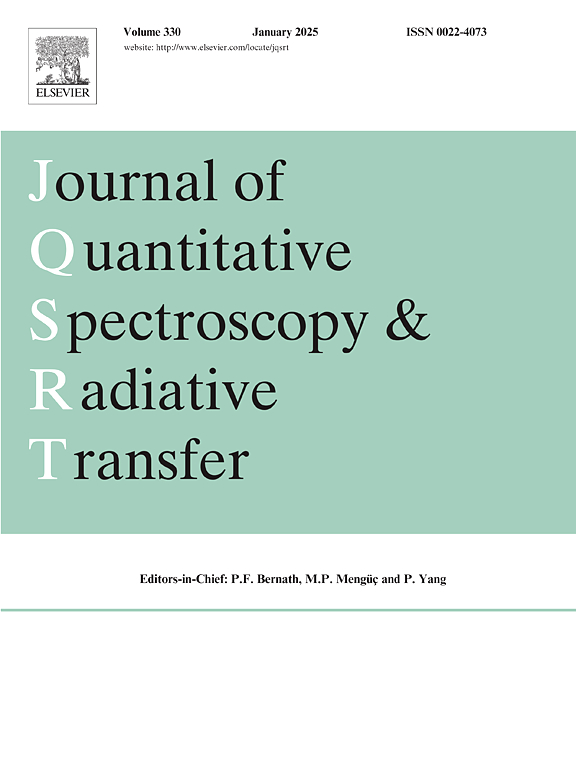High resolution spectroscopic analysis of the v2 = 1 and v4a = 1 states of 14ND2H
IF 2.3
3区 物理与天体物理
Q2 OPTICS
Journal of Quantitative Spectroscopy & Radiative Transfer
Pub Date : 2025-04-25
DOI:10.1016/j.jqsrt.2025.109497
引用次数: 0
Abstract
Transitions of ND2H have been detected in the high-resolution spectra of 14ND3 recorded in the region 60 − 1515 cm−1, using the Bruker IFS 125 Fourier transform spectrometer located at the synchrotron far-infrared beamline, Canadian Light Source. In this study we report on the observation and analysis of transitions to and between the s, a inversion levels of the v2 = 1 and v4a = 1 states for ND2H. We assigned to v2 = 1 (v4a = 1) 996 (296) rotation-inversion transitions, with J up to 19 (13), and 3578 (1966) vibration-rotation-inversion transitions from the ground state, with up to 22 (13). The newly assigned transitions, together with those present in the literature, were fitted on the basis of a Watson-type S reduced Hamiltonian using the IIIl representation. The model includes terms up to the 10th power of the angular momentum and vibration-rotation interaction terms between the inversion levels. Precise and extended sets of spectroscopic parameters and term values were derived for the s, a v2 = 1 and v4a = 1 states as results of least squares weighted fit procedures that reproduce the transition wavenumbers at experimental accuracy.
14ND2H的v2 = 1和v4a = 1态的高分辨光谱分析
利用位于加拿大光源的同步远红外光束线的Bruker IFS 125傅立叶变换光谱仪,在记录的14ND3的60 ~ 1515 cm−1区域的高分辨率光谱中检测到ND2H的跃迁。在本研究中,我们报告了ND2H在v2 = 1和v4a = 1状态的s, a反转能级之间的转变的观察和分析。我们将v2 = 1 (v4a = 1)分配到996(296)个旋转-反转转变,其中J高达19(13),以及3578(1966)个从基态开始的振动-旋转-反转转变,其中J '高达22(13)。新分配的过渡,连同文献中存在的过渡,都是在使用IIIl表示的沃森型S约简哈密顿量的基础上拟合的。该模型包括高达10次的角动量项和反演层之间的振动-旋转相互作用项。作为最小二乘加权拟合程序的结果,得到了s, a v2 = 1和v4a = 1状态的精确和扩展的光谱参数和项值集,以实验精度再现了过渡波数。
本文章由计算机程序翻译,如有差异,请以英文原文为准。
求助全文
约1分钟内获得全文
求助全文
来源期刊
CiteScore
5.30
自引率
21.70%
发文量
273
审稿时长
58 days
期刊介绍:
Papers with the following subject areas are suitable for publication in the Journal of Quantitative Spectroscopy and Radiative Transfer:
- Theoretical and experimental aspects of the spectra of atoms, molecules, ions, and plasmas.
- Spectral lineshape studies including models and computational algorithms.
- Atmospheric spectroscopy.
- Theoretical and experimental aspects of light scattering.
- Application of light scattering in particle characterization and remote sensing.
- Application of light scattering in biological sciences and medicine.
- Radiative transfer in absorbing, emitting, and scattering media.
- Radiative transfer in stochastic media.

 求助内容:
求助内容: 应助结果提醒方式:
应助结果提醒方式:


